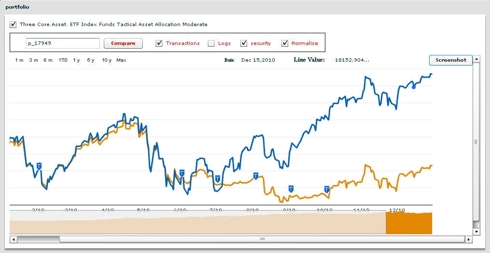Simple ETF Portfolio Demonstrates the Limits of Momentum Strategies
01/01/2011 0 comments
There is significant public and private debate about the use of tactical asset allocation compared to the
venerable strategic asset allocation. Both have benefits and both have weaknesses that means that it is important to
bound their use and not to trust them blindly.
We created the SIB (Simpler Is Better)
Portfolio -- on index fund for each asset class -- which an asset class benchmark and we are going to use the simplest -- 3 asset class SIB to
demonstrate the differences between the two strategies and show their benefits and weaknesses. The three asset class SIB has VTI (US), VEU (International) and BND (fixed income) -- as well as cash.
If we take a moderate portfolio
for both strategies (40% fixed income) we see the following historical returns.
| Portfolio Name | 1Yr AR | 1Yr Sharpe | 3Yr AR | 3Yr Sharpe | 5Yr AR | 5Yr Sharpe |
|---|---|---|---|---|---|---|
| Three Core Asset Index Funds Tactical Asset Allocation Moderate | -1% | -15% | 2% | 26% | 6% | 53% |
| Three Core Asset Index Funds Strategic Asset Allocation Moderate | 10% | 78% | 1% | 4% | 6% | 29% |
We note that tactical asset allocation has significantly underperformed in the short term but does better over the long run.
If we look
into the history a little deeper, we can see what is going on. This historical graph shows the performance of the two portfolios with T markers for when
transactions occurred with the tactical asset allocation strategy.
What happened?
The TAA portfolio started to hold VEU and VTI (intl and US equity) in 8/2009 -- this tracks very closely with the SAA portfolio.
The TAA then started to liquidate, first VEU and then VTI in 6/2010 and 7/2010, when both were at market lows. The market recovered and it got back
to the market on 10/1/2010.
The problem is that it sold at low while the other side (the fixed income side) did not do that much during that 6-
9/2010 period, as a hedge, thus losing ground until it started to recover afterwards.
Takeaways:
- Momentum (TAA) alone on ETFs or any asset does NOT work well. It has to have other hedging assets that respond to movement
- Three asset class portfolios are going to be more vulnerable to this as there aren't other uncorrelated asset classes to be a hedge
In the next article, we will go back a little further and where TAA does work well and is what enables the portfolio to recover in the longer term.
labels:investment
Symbols:SPY, QQQQ, IWM, MDY, EFA, VEU, EEM, VWO, IYR, ICF, VNQ, GSG, DBC, DBA, USO, LQD, CSJ, CIU, HYG, JNK, PHB, TLT, IEF, SHY, SHV, BND, AGG, MUB, MBB
comments 0
